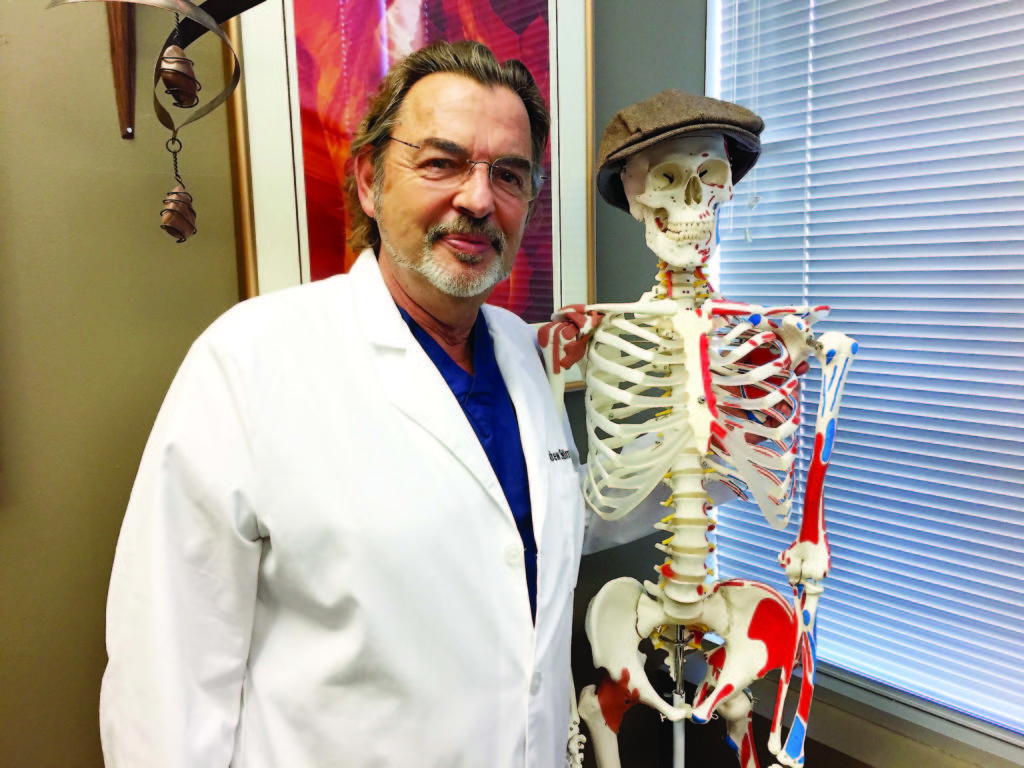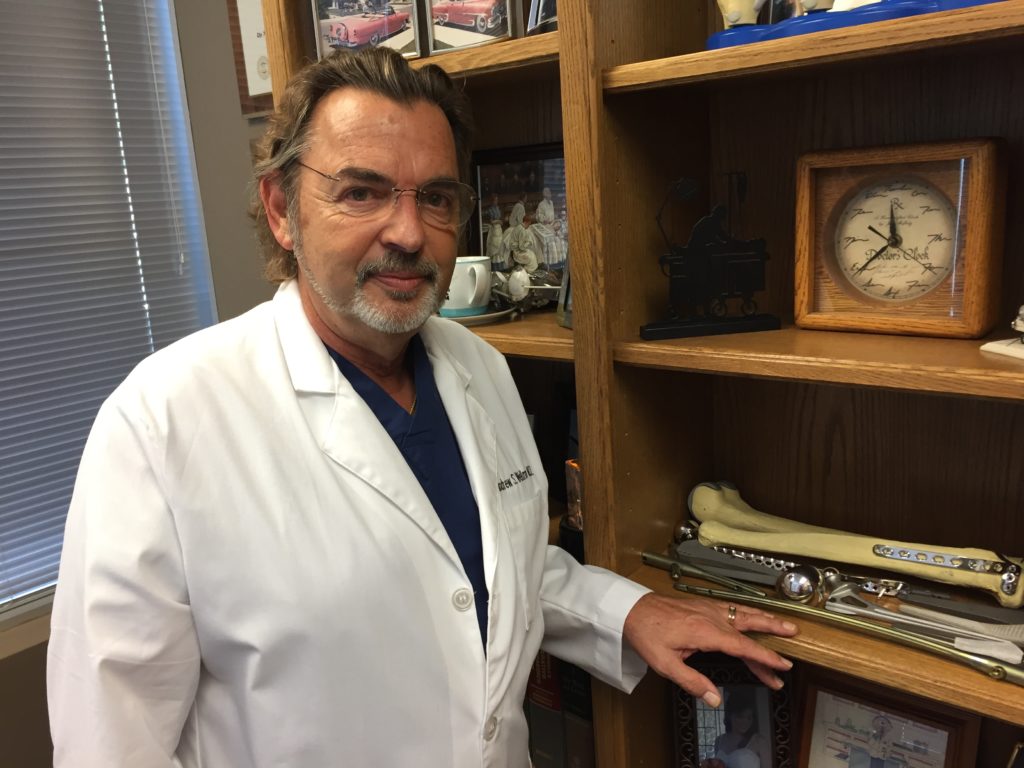
who helps show patients around the joint, as it were. — Wrangler News photo by Joyce Coronel
By Deborah Hillcove
Dr. Andrew S. Wellman leans back in his chair, surrounded by a wall of books. Photographs of architecture and brilliant-colored fish suggest his photography and scuba diving hobbies. Soft music plays. A life-size skeleton nicknamed “Bones” stands in a corner, wearing a rakishly perched, plaid driving cap.
A single glance confirms the wide ranging panorama of how the West Chandler orthopedic surgeon, affiliated with Arizona Orthopedic Surgical Specialists, sees the world around him.
There’s more: A pair of pale green, translucent jellyfish—marine creatures lacking bones—float aimlessly in a small aquarium, their tentacles trailing gracefully. “They remind me how peaceful places still exist in the world,” Wellman says.
“They tend to relax people in the office, as well as me.”
Born in London, raised in New York City, fluent in French and Spanish, Wellman was educated at the Autonomous University of Guadalajara. He entered the U.S. Army Medical Corps and was stationed at the Letterman Army Medical Center in San Francisco, studying cardiology.
However, he says he discovered a “keen attraction” for the operating room, which seemed “like a sandbox, filled with wonderful toys.” He “switched boats,” he noted, and began studying orthopedic surgery.
“The Army has a crackerjack program,” he says, “and it was a fabulous experience. I have nothing but gratitude for the U.S. Army.”
Upon finishing his medical studies with a promotion to major, Wellman was invited by an Army friend to join his surgical practice in Arizona. That was 34 years ago, and today, among other procedures, Wellman treats carpal tunnel syndrome, rotator cuff injuries, fractures, occupational and sports injuries, as well as joint problems.
In fact, he says, with winter visitors and several retirement communities nearby in Chandler and Tempe, many of his surgeries are hip replacements for older people—and now for aging baby boomers.
The predominance of total hip replacements tallies with reports from The Center for Disease Control, showing chances of a hip fracture increase with age. In 2016 the CDC reported more than 300,000 Americans over the age of 65 were hospitalized for THR surgery.
Some of the surgeries resulted from bone and joint diseases like osteoporosis, osteoarthritis and rheumatoid arthritis.
However, the CDC estimates 95 percent of all hip replacements are caused by falling. Of this figure, women suffer three of every four hip fractures, often worsened by osteoporosis.
A total hip replacement requires the head of the femur, or thigh bone, and its socket to be replaced. Imagine doubling your fist and fitting it into the cup of your other hand. The cupped hand is like the socket, or shell. The fist and forearm resemble the ball joint and femur, the long bone connecting the hip to the knee.
Wellman describes the ball joint as “smooth, like a cue ball. With disease and wear, however, it begins to resemble a cauliflower.” An X-ray can show the severity of the worn joint.
Wellman notes that he was classically trained and, although knowledgeable of minimally invasive and robot-assisted techniques, he prefers “to make an elegant incision, large enough to see clearly, and then peel back the layers [of tissue] to work.”
The diseased portion is scraped away, leaving healthy bone.
 Once inside, he can select the appropriate shell and ceramic ball joint. The stem fits into the marrow of the femur. Both the shell and part of the femoral stem have microscopic “honeycombed” surfaces, allowing the bone to grow into the prosthetics and enhance stability.
Once inside, he can select the appropriate shell and ceramic ball joint. The stem fits into the marrow of the femur. Both the shell and part of the femoral stem have microscopic “honeycombed” surfaces, allowing the bone to grow into the prosthetics and enhance stability.
Within a day of surgery, a patient will receive assistance to move and will be discharged within three to five days. Recovery will include physical therapy, and a normal lifestyle can usually be resumed within months.
Notes Wellman:
“There is always a choice [about having the surgery]. If a patient has tried weight loss and appropriate medication, yet still suffers constant pain, then surgery can be a life-changing event. However, it alone will not change your life. Life is what you make it. If a person has a healthy lifestyle, yet is impaired, then surgery can be a wonderful option. It is liberating.”
His next surgery involves a 91-year-old lady. Wellman says she is a prime candidate for THR and has very few medical problems. Until recently, she swam and walked daily, but pain has increased, and she’s unable to sleep. Instead of being angry, Wellman says, “She’s annoyed. She wonders, ‘How dare my body betray me!’”
Patients like that, he says, “take a grip on life, mentally and physically. They’re the best candidates. Because they’ve approached life that way, typically there’s no fat on their bodies, and that makes the surgery outcome better. A patient’s lifestyle reflects the required determination to rehabilitate, return to a normal life.”
“I take great pride in making this [replacement] as perfect as I can,” he says. Most patients, when asked post-rehabilitation how they feel about the surgery, respond, “If I could go back in time, I’d change my lifestyle, 20-30 years ago, and avoid this.”
Other patients who have successfully returned to an active life, enthuse, “I wish I’d done it five years ago!”
Information: www.andrewwellmanmd.com.

